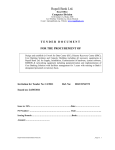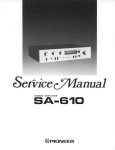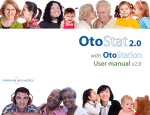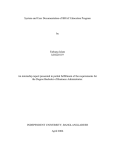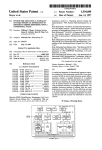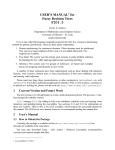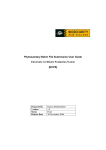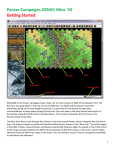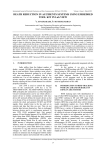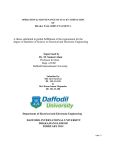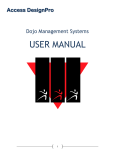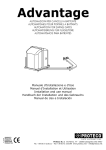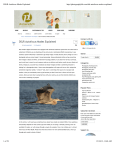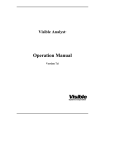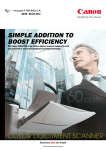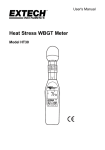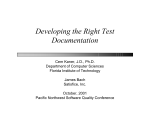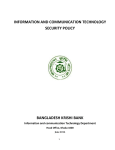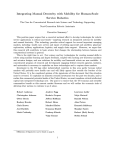Download Internship Report A System Analysis in the Basis of Corporate
Transcript
Internship Report A System Analysis in the Basis of Corporate Customer Tracking for Selling and Maintaining Service Products Prepared ByMs. Shahnaz Afreen ID-0110206 April 30, 2006 Mr. Ashikur Rahman Business School Independent University, Bangladesh Baridhara, Dhaka - 1212 Subject: Letter of Transmittal Dear Sir, I hope you will be pleased to know that I have completed my Internship in Standard Chartered Bank in the Solution Delivery Department. It gives me immense pleasure to complete my Internship successfully and submit this report on the analysis I have conducted during my internship period. At every segment of making this report, I tried to enhance my knowledge about the system or work flow of Standard Chartered Bank. This report will try to give the picture of my efforts and ability. It would be very kind of you for examine my Report work and give me further suggestions and enhanced my clarification due to future prospects. Sincerely yours, Ms. Shahnaz Afreen ID-0110206 PREFACE Banking Business is appearing to be the dominant factor in recent years. Long before, since the emergence of Banks and similar activities was to attracting people to save valuable possessions and engaging more people in it. But with the change in time and technology the pattern of Bank business activities has also changed. It is now changing in every day with the changing world with competent man and cutting edge technology to fulfill its goal for the people. Today it is widely recognized that information systems knowledge is essential for managers because most organizations need information systems to survive and prosper. Information systems can help companies to extend their reach to faraway locations, offer new products and services, reshape jobs and workflows, and perhaps profoundly change the way they conduct business. My report covers the importance of an effective information system that consists of a set of people, procedures, and resources that collects, transforms, and disseminates information in an organization. It will show how the absence of an effective information system can create problems for the managers to analyze problems, visualize complex subjects and create new products. Besides finding the drawbacks of a current information system it will also provide the solution that can help the organization to gain strategic advantages over their competitors. ACKNOWLEDGEMENT I am grateful to many individuals for the completion of the report successfully. Independent University Bangladesh (IUB) and Standard Chartered Bank both provided enormous support and guidance for my Internship program worth full. First of all, I would gladly like to thank the School of Business of IUB and Standard Chartered Bank for giving the opportunity of having an Internship program and allow me to submit my report based on the Customer tracking in the context of Product Distribution for Standard Chartered Bank. I have gathered an enormous deal of experience while going through the intern period and preparation of this report. I would like to thank to my Internship Supervisor in IUB, Mr. Asiqur Rahman for his excellent guidance and support during the preparation of the report. A special thanks goes to my Internship Organization Supervisor in Standard Chartered Bank, Mr. MD. Shoeb Ali for providing me support and courage throughout my Internship program and helping me to accumulate necessary information. I also like to extend my gratitude to Mr. Nasim Haider Rana from Solution Delivery Department for helping me by giving the valuable information and on behalf of their company and give me time to understand banking concept. And a special thanks goes to Mirza Aminur Rahman Head Transaction Banking of SCB, for his support this internship program became achievable for me. Lastly, my heartiest thanks go to others who were involved and helped directly and indirectly in completion of internship and preparing this report. Without them all these wouldn’t be made possible. CONTENTS Preface………………………………………………………………….……………..xix Acknowledgement…………………………………………………………………….xxi 1. Chapter 1: Background of the Report 1.0 Introduction………………………………………………………...……………1 1.1 Objective of the Study………………………………………………………….1 1.2.1 Primary Objective………………………………………………………1 1.2.2 Secondary Objective……………………………………………………1 1.3 Rationale of selecting Standard Chartered Bank……………………….....2 1.4 Commitment to and from Standard Chartered Bank………………………2 2 Chapter 2: Introducing the Organization 2.0 Introduction of the Organization……………………………………….……3 2.1 Background of the Company…………………………………………….….3 2.2 A Brief History of Standard Chartered Bank………………………….……4 2.3 Corporate Responsibility………………………………………………..……4 2.4 Organizational Profile………………………………………………………...6 2.5 Market Growth………………………………………………………………...7 2.5.1 SCB Global Operating Region…………………………………………….7 2.5.2 Standard Chartered Bank in Bangladesh…………………………….8 2.5.3 Standard Chartered Today………...…………………………………10 3 Chapter 3: Overview of Banking Services 3.0 Consumer and Corporate Banking Services……………………….…….11 3.1 Corporate Product Description……………………………………….……12 3.2 Foreign Exchange Products and Services……………………………….13 4 Chapter 4: Fact Finding Techniques 4.0 Organizational Hierarchy and Structure………………………………..…14 4.1 My Work Area……………………………………………………….…….…15 4.2 Applied Fact Finding Techniques………………………………….………15 4.3 Interview………………………………………………………………………15 4.4 Document Review………………………………………………………..….18 4.5 The Goal…………………………………………………………..………….19 4.6 A Brief Description of SCB Products………………………………….…..19 4.7 Gann Chart………………………………………………………..……….…21 4.7.1 Limitations………………………………………………….………….22 5 Chapter 5: Description of Ongoing System 5.0 The Current System of Solution Delivery Department…………………….…..23 5.1 AS-IS Process Description……………………………………………………….23 5.2 The AS-IS Process………………………………………………...……………...24 5.3 Corporate Banking Service Charges Categories……………………………...27 6 Chapter 6: Analyzing and Constructing Data Model 6.0 Data Flow Diagram…………………………………………………..……………28 6.1 Level 0 DFD………………………………………………………….…………….29 6.2 Level 1 DFD………………………………………………………………………..31 7 Chapter 7: Problem Recognition 7.0 Problem Identification……………………………………………………………..40 7.1 Problem Statement………………………………………………………………..41 7.2 The Reason for which the Problem needs to be Dissolved…………………..42 7.3 Use Case Diagram………………………………………………………………..43 7.4 Use Case Narrative……………………………………………………………….48 8 Chapter 8: Analyzing the Problem 8.0 Analyzing the Problem……………………………………………..……………..49 8.1 Symptoms…………………………………………………………….……………49 8.2 Scope………………………………………………………………….……………49 8.3 Domain……………………………………………………………………………..50 8.4 Interfaces…………………………………………………………………………..50 8.4.1 Effects…………………………………………………………….………….51 8.5 Specific Problem Criteria…………………………………………………………51 8.6 Problem Causalities…………………………………………………...………….52 8.6.1 Fish Bone Diagram………..……………………………………..…………54 8.6.2 Rich Picture………….…………………………………………….......……55 8.6.3 Activity Diagram…..…...……………………………………………………57 9 Chapter 9: Defining Hypothesis 9.0 The Proposed System…………………………………………………………….59 9.1 Hypothesis…………………………………………………………………………59 9.2 Primary Solution………………………………………………………….………..59 9.3 Feasibility Analysis……………………………………………………………..…60 9.3.1 Feasibility Analysis of the Selected Solution……………………………..60 9.3.2 Why I Choose this Solution………………………………………………...61 9.4 TO-BE Process……………………………………………………………………62 9.4.1 TO-BE Process Description………………………………………………..65 10 Chapter 10: Risk Assessment 10.0 Risk Analysis………….………………………………………………………….66 10.1 Risk Identification…….………………………………………………………….66 10.1.1 System Crash.…...………………………………………………………….66 10.1.2 Employee Risk….…………………………………………………………..66 10.1.3 Technological Risk………………………………………………………….66 10.1.4 Development Risk…………………………………………………………..67 10.1.5 Physical Damage.…………………………………………………………..67 10.2 Risk Mitigation………..…………………………………………………………..68 11 Chapter 11: Analyzing the Requirements 11.0 Requirement Analysis………………………………………………………...…69 11.1 Current System Analysis……………………………………………………..…69 11.1.1 Hardware Status……………………………………………………………69 11.1.2 Software Status………………………………………………………….….69 11.1.3 Required Requirements……………………………………………………69 11.1.4 Employees Learning Status……………………………………………….70 11.2 Budget Analysis……………………………………………………………….71 12 Chapter 12: Data Modeling 12.0 Entity Relationship Diagram…………………………………………………….72 12.1 Conceptual ERD…………………………………………………………...…….72 12.2 Logical ERD……………………………………………………………………...74 12.3 Data Dictionary…………………………………………………………………..76 13 Chapter 13: Interface Architecture 13.0 Interface Designing………………………………………………………………84 13.1 User Interface and its Description……………………………………………...84 13.2 User Guide………………………………………………………………………..84 14 Chapter 14: Conclusion 14.0 Conclusion………………………………………………………………………..99 15 Chapter 15: References and Appendix Reference………………………………………………………………………100 Appendix………….. ………………………………………………………… ..101 CHAPTER 1 Background of the Report 1.0 Introduction 1.1 Origin and Background of the Report This report is being assigned as a part of the Degree BBA 499A, (Internship). To prepare this report under the state of University’s requirement, I accommodate my internship program in Standard Chartered Bank. For the completion of the course, as an essential part I had prepared Report. This report is being formed on the most vital issue which is Customer Tracking and Product selection process. At the very beginning of my internship I have studied different functional departments of the organization. By going through all the departments I have chosen the solution delivery department for my study and analysis. 1.2 Objective of the Study The objective of my study can be divided into two segments. These are given below: 1.2.1 Primary Objective The primary objective of this report is to meet the requirements of the course, BBA 499A, Internship. 1.2.2 Secondary Objective The secondary objectives are: To analyze the present system of Solution Delivery Department in Standard Chartered Bank, basically to find out the effectiveness of the current system. To identify the problems (if any). Finding out the possible solutions to eliminate the problems. And most of all to gain a life time experience by working as an intern and achieving knowledge. 1.3 Rationale of selecting Standard Chartered Bank Advanced technology and skilled workforce become the most essential elements to go ahead with the competitors in today’s dynamic Banking Business World. It seams like that the Technology advancement is emerging immensely in every corner of the world. It has become very difficult to stay in the competitive market without remaining update with the new technological inventions, which are ensuring competitive advantages over other organization. Other like the whole world Banking industry in Bangladesh is also became highly competitive. Let alone the world only in Bangladesh there are about 4 Government Banks, 2 Semi- Government Banks and about 50 Private Banks. This area of business provokes no less interest than others and Standard Chartered Bank is perceived to be one who is going ahead with tremendous growth rate over the centuries. Apparently this organization runs very smoothly, but since the purpose of my internship report is to search process-oriented problems, the rationale of picking this organization is, to see the changing processes, to see the efficiency of the particular processes, and analyze whether any new technology can be implemented in the on going system and generate documents. 1.3.1 Commitment to and from Standard Chartered Bank There has been mutual commitment resulted a pseudo fiduciary relationship between me and Standard Chartered Bank management that all the information obtained would solely focus on the internship project and other parties will never enter in the scenario. The management promised all necessary documents and allowed access to all required software and processes. I was introduced to the staffs related with Sales and Distribution in Standard Chartered Bank so that the flow of information is not hampered during the project. CHAPTER 2 Introducing the Organization 2.0 Introducing the Organization 2.1 Background of the Company Standard Chartered Bank – leading the way in Asia, Africa And the Middle East Standard Chartered is one of the world's largest international banks, employing over 40,000 people, representing 80 nationalities, across its network. Standard Chartered operates in over 1,200 locations (including subsidiaries, associates and joint ventures) in more than 50 countries in the Asia Pacific Region, South Asia, the Middle East, Africa, the United Kingdom and the Americas. Standard Chartered PLC is listed on both the London Stock Exchange and the Stock Exchange of Hong Kong and is in the top 25 FTSE-100 companies, by the market capitalizations. It serves both Consumer and Wholesale Banking customers. Consumer Banking provides credit cards, personal loans, mortgages, deposit taking and wealth management services to individuals and small to medium sized enterprises. Wholesale Banking provides corporate and institutional clients with services in trade finance, cash management, lending, securities services, foreign exchange, debt capital markets and corporate finance. Standard Chartered is well-established in growth markets and aims to be the right partner for its customers. The Bank combines deep local knowledge with global capability. The Bank is trusted across its network for its standard of governance and corporate responsibility as well as its commitment to making a difference in the communities in which it operates. 2.2 A brief History of Standard Chartered Bank Bank opened its first branch in Brunei Darussalam in 1958. And now it has being awarded the industry’s first ISO 9002 in the country. Standard Chartered Bank is an international Bank, with particular focus on activities in Asia, Africa, The Middle East and Latin America. The Bank has a network of 740 branches in over 55 countries. Its aim is to provide innovative products, supported by quality deliver system and customer service. Bank also boasts a corporate responsibility that gives back to the community in which it operates. Amongst the top priorities are youth resulted projects, as well as those supporting health and childcare. (www.standardchartered.com) As a financial solution provider, Bank offers a wide range of products and services to a broad customer base in Brunei Darussalam. 2.3 Corporate Responsibility At Standard Chartered bank they recognize that, they have an impact on the economies, communities and on the environment in which we operate and a responsibility to address this impact. They also identify that through their business activities they can contribute to sustainable development. Climate Change, selling our products responsibly, tough economic or political conditions are just some of the environmental and social issues faced by an international bank like this Standard Chartered. They also believe that by facing up to challenges such as these and by addressing them as part of our everyday business life we can make our brand stand out from the competitors. These Corporate approaches are being continued from the year 2004 and till today. This part of our approach to Corporate Responsibility, our policies and describes spread responsible business practices throughout the bank. Business Structure Treasury Institutional Commercial Local Figure-1 : Business Structure Corporate Quasi. Govt. Multinational Still today Standard Chartered Bank have the similar kind of Bank structure showing above. 2.4 Organization Profile In the below table the Organization profile is being given in short: Organization Profile 1. Organization Name Standard Chartered Bank. 2. Establishment of The 1958 Bank 3. First Location of the Bank Brunei Darussalam 4. Address of Head Office Ground Floor, Unit 1&2, Simpang 570, Jalan Tutong, Bunut, Brunei Darussalam BF1320. 5. Telephone Number +673 2651774 6. Total Branch Number 600 offices in more than 50 countries 7. Total Staff Number A staff of about 28000 people managing assets worth 47.65 billion 8. Establishment In Bangladesh 1948 including ANZ Grindlays experience; Standard Chartered Bank originally established it’s first branch in Chittagong 9. Address of Head Office Bangladesh Hadi Mansion 2nd Dilkusha Commercial Area Dhaka-1000, Bangladesh 10. Phone Number of Head Office Bangladesh +8802 955 5171 11. Website Address www.standardchartered.com 12. E-mail [email protected] 2.5 Market Growth Standard Chartered provides domestic and international issuers with customized local and G3 currency debt financing solutions through Origination, Sales and Trading teams located in 18 centers across the world. Utilizing a range of capital market instruments including Fixed and Floating Rate Notes, Variable Rate Notes, Medium Term Notes and MTN programs, Commercial Paper, Certificates of Deposit and Bills of Exchange, the bank provide clients with a wide range of capital raising alternatives. The Bank has established a strong track record in the Asian bond markets, leveraging on our strengths in local and G3 currency bond issuance. Combining indepth understanding of the domestic debt markets with product expertise and a wide geographic reach, Standard Chartered will work with their Clients to customize the most effective capital markets solutions and provide strategies to achieve for the financing and investment objectives. The local and G3 currency capabilities are backed by effective marketing and distribution in both onshore and offshore markets, and we provide strong research and after-market trading support for every transaction. 2.5.1 SCB’s Global operating regions The Standard Chartered group is operating in 48 countries in various extents. These countries are grouped into 5 regions based on their location and core business focuses. Africa: (Includes 11 countries) Botswana, Cameroon, Gambia, Ghana, Kenya, Sierra Leone, South Africa, Tanzania, Uganda, Zambia, and Zimbabwe. Asia Pacific: (Includes 17 countries) Australia, Brunei Darussalam, Cambodia, China, Hong Kong, Indonesia, Japan, Laos, Macao, Malaysia, Myanmar, Philippines, Singapore, South Korea, Taiwan, Thailand, Vietnam. Latin America: (Includes 6 countries) Argentina, Brazil, Colombia, Mexico, Peru, and Venezuela. Middle East and South Asia: (Includes 10 countries) Bahrain, Bangladesh, India, Iran, Nepal, Oman, Pakistan, Qatar, Sri Lanka and United Arab Emirates. UK & USA: (Includes 4 countries) Falkland Islands, Jersey, United Kingdom and United States of America. (www.standardchartered.com) 2.5.2 Standard Chartered Bank in Bangladesh The Chartered Bank started operating in Bangladesh in 1948, opening a branch in Chittagong. The branch was opened mainly to facilitate the post-war reestablishment and expansion of South and Southeast Asia. The Chartered Bank opened another branch in Dhaka in 1966, where it is still headquartered. After the merger of the Chartered Bank with the Standard Bank in 1969, the Standard Chartered Bank took up a program of expansion. It increasingly invested in people; technology and premises as its business grew in relation to the country's economy. In 1993, there was an organizational re-structuring, which led to a substantial expansion of the Bank's business. Today the bank has in total four branches in Dhaka apart from the Chittagong branch, including an offshore branch at the Savar Export Processing Zone. Bangladesh is under the Middle East and South Asia (MESA) region, with the controlling office in Dubai. Its correspondent relationship with Sonali Bank, the largest bank in Bangladesh, gives its customers access to all major centers in the country. Standard Chartered Bank's worldwide network facilitates convenient connections with foreign trade and remittance business. Standard Chartered Bank's branch banking license in Bangladesh allows it to offer a full range of banking services. At present the Bank has ten branches in Dhaka, it also have one offshore banking unit inside the Dhaka Export Processing Zone at Savar, one branch in Narayanganj, three branches in Chittagong, one branch in Khulna, one branch in Sylhet, one branch in Bogra. In the year 1999, Standard Chartered has acquired the operation of Grindlays Bank in the Middle East and South East Asian countries. Former Grindlays Bank started its journey in Bangladesh in 1905 under the name of Grindlays Bank (when it forbears the National Bank of India opened in Chittogong). Standard Chartered Bank took-over the operation of ANZ Grindlays Bank in Bangladesh as a part of acquisition of the South East Asian and Middle East operation of the Australia and New Zealand Banking Group. SCB with its 18 branches and booths across Bangladesh has employed more than 600 people. The acquisition of ANZ has enabled Standard Chartered Bank (SCB) to access 500,000 new customer and 40 branches in India, and this made them one of the biggest banks in this region and of in Bangladesh it is the largest foreign bank. After acquisition, Grindlays Bank is a part of Standard Chartered Group. The Bank presently has 18 outlets in 5 cities serving over 1,25,000 customers in the country. The network of SCB Bank in Bangladesh includes: 10 Branches in Dhaka city 1 Branch in Savar EPZ (recently started with full banking operations) 1 Branch in Narayanganj 3 Branches in Chittagong 1 Branch in Khulna 1 Branch in Sylhet. 1 Branch in Bogra 2.5.3 Standard Chartered Today Standard Chartered employs 38,000 people in 950 locations in more than 50 countries in the Asia Pacific Region, South Asia, the Middle East, Africa, the United Kingdom and the Americas. Standard Chartered is one of the world's most international banks, with employees representing 80 nationalities. Standard Chartered PLC is listed on both the London Stock Exchange and the Stock Exchange of Hong Kong and is in the top 25 FTSE-100 companies, by market capitalization. The most recent news is this that the Bank is in the process to move forward into a bigger strategic breakthrough. By Establishing this plan will change total Bank’s functional structure. As previously the bank was having their structure like corporate branch and consumer banking. But for implying this new strategy the Bank is having this new sector called the Transaction Banking. And the major change is that like all the other bank’s the liability or the assets sector won’t be separated. These two major sectors will merge. By changing this major strategy the bank is making a revolution within the baking sector in Bangladesh and the rest of the World. Standard Chartered is well-established in growth markets and aims to be the right partner for its customers. The Bank combines deep local knowledge with global capability. The Bank is trusted across its network for its standard of governance and its commitment to making a difference in the communities in which it operates. CHAPTER 3 Overview of Banking Services 3.0 Consumer and Corporate Banking Services The bank serves both Consumer and Wholesale Banking for customers or corporate clients. A list of Consumer and Corporate Banking is given below: Serial Services No Banking provides credit cards, personal 1 ATM 2 Branch Office 3 Remote Branches 4 Call Center 5 Card Center loans, mortgages, deposit taking and wealth management services to individuals and small to medium sized enterprises. Wholesale Banking provides corporate and institutional clients with services in trade finance, cash management, lending, securities services, foreign exchange, debt capital markets and corporate finance. 6 Cards Help line 7 Cash Offline 8 Consumer Banking 9 Corporate investor relational contracts 10 Credit Card service 11 Personal Banking 12 Offsite ATM 13 Off Shore Banking Personal banking 14 Treasury Room 15 Phone Banking 16 International Banking In the following the products descriptions are given: corporate 3.1 Corporate Product Description Serial 1 Product Name Web Banking Description Total Customer Online service; where a corporate customer can 102 check his current account balance updated in every half-an-hour. This is very convenient as a customer can have opportunity to hold multiple accounts and at same time they can get the cash report trade report and everyday transaction detailed report. 2 STS Straight through service. This is an upgraded 1 (On trail) version of E-Banking, with more facilities. This is still in the process for developing 3 E-Banking By having high security off-line banking system a 29 customer can transfer money round the clock and standing any parts of the world. 4 i-Payment This is a new module under the internet Banking. 2 (On trail) by this module using SMART card an authorized user can transfer the payment or issuing draft from any time and any corner of the world via Internet. 5 CheqWriter Making sure that all the cheaque is being preformed and serially numbered, a 104 corporate customer now having a better security checking in terms of issuing cheaques. In the following a diagram for the Customers product using ratio is being given: Corporate Product Using Ratio Web Bank 43% Cheaque Writer 45% e-Banking STS 0% 12% Web Bank STS e-Banking Cheaque Writer Figure: Product Using Ratio 3.2 Foreign Exchange Products and Services Money Market Products Interest Rate and Cross Currency Derivatives Foreign Exchange, Forwards and Swaps Money Market Funds Online Electronic Trading Services Global FX and Economic Research CHAPTER 4 Fact Finding Techniques 4.0 Organizational Hierarchy Structure Organ gram of Standard Chartered Bank CEO Head of IT Head of Consumer Head of Credits Chief Finance Officer Head of GSM Multinationals MNE (Assets) Head of Products Head of Global Market Assistant Manager of Supply Chain Large Local (Assets) Head of Solution Delivery Head of Service Delivery Head of Corporate Affaires Head of CR Head of Transaction Banking (Liability) Head of Supply Chain Head of HR Chief Operating Officer Local (Assets) Direct Report (BDM-Business Development mgt.) Assistant Manager of Solution Delivery 4.1 My Work Area Cash management Department Standard Chartered is highly recognized as a leading cash management supplier across the emerging markets. Our Cash Management Services cover local and cross border payments, collections, information management, account services and liquidity management for both corporate and institutional customers. Some Features are given below: Manage the availability of client’s funds efficiently Monitor and control the movement of funds Settle payments to client’s suppliers in a timely and cost-effective manner. Capture every investment opportunity to increase your income Here from this above Organogram we can analyze my work area. If we just follow the blue colored box then Under the Solution Delivery Manager I started my work. This department is particularly being responsible for delivering products and gives services to its customer. And give up-to date information to the management department. 4.2 Applied Fact Finding Techniques For gathering necessary information and understand the system I have applied several fact finding techniques at different point of time whenever I need to require information. The mechanisms or techniques used in this project are, Interviewing Observing Document Reviewing Questionnaire Survey (In a limited Basis) The process of applying these techniques are describes on the following sections. (Haque, I. (2004). Course Handout of MIS and System Analysis. IUB.) 4.3 Interview Interviews are much more productive than any other techniques applied to understand a system. It provides face-to-face communication and gathering of sample data. The interviews were conducted at transaction banking, Head Office, Bangladesh. Several interviews took place at different times through the internship periods. As it was my workplace so arranging an interview at any convenient time was possible without any appointment. Most often the interviews were conducted between the times 10:00 am to 3:00 am and 5:00 pm to 3:00 pm. These interviews were arranged with the Sales Solution Delivery Manager, Assistant Manager of Solution Delivery Department, *** Department IT and ** of HRD. Here is an interview agenda given that I have used during the interview with the Solution Delivery Manager. Interviewee: Mohammad Shoeb Ali, Solution Delivery Manager Subject: Analysis of the three categories of Products Time and Date: 2.00 to 2:45 pm, February, 2006 Duration: 50 minutes (App.) Venue: Solution Delivery Manager’s Cabin, Head Office, Standard Chartered Bank. Questions: Estimated Time 1. A brief Idea about the Products and its uses? 4 min 2. What type of customer uses these products? 4 min 3. How do you Track Customers? 3 min 4. Do you conduct any analysis on the information? 3 min 5. What types of routine instructions do you usually gives on the basis of daily customer requirements? 4 min 6. What information helps you in this case? 3 min 7. Whom do you give all these instructions? 2 min 8. Do you generate any further report on the basis of daily sales information? 9. How do you compare the actual sale with the target? 2 min 4 min 10.What do you do when you need any instant sales information? 5 min 11. What type of strategic decisions do you make? 5 min 12.Briefly narrate the understandings. 4 min 13. Any further queries from both sides. 2 min 1 min 14. Thank you session. 5.4 Observation Through observation analysts I was able to obtained firsthand information about how the activities are carrying out. While observing I have got the idea about how the different processes are carried out, how documents are handled, whether any specific activity creates any problems in the smooth dataflow through the organization. Because observation is, “A critical view into the actions gestures, body language, technical efficacy and attitude that leads to a process definition, compilation and adroit execution of organizational standards”. Observation took place at the Transaction Banking Solution Delivery Department (1st Floor) and also the HR Department (2nd Floor) of Head Office of Standard Chartered Bank. I had the opportunity of observing during the peak period of sales that is at the month of February and March. That’s why it was easy to understand the whole process and to identify the problems. Generally the observations took place at Head Office after 2:00 pm. Here is a sample observation plan of sales reporting system from the bank. Sample Observation Plan ¾ Who (The role): Solution delivery Manager (1), Computer Operators (2) ¾ What (The process): Making the contract for setting up the justified products (Products can be multiple one). ¾ When (Time & Date): 1:00 to 2:00 pm, February 2, 2005, Monday ¾ Where (Location): Head Office, Dhaka, Standard Chartered Bank ¾ Why (Rationale): To know that how products are being justify for different Corporate Customers and reporting system of computer section in depot to the Solution Delivery Manager and Back Office. ¾ How (Technique): Simply stayed in the Solution Delivery Department 4.4 Document Review Documents represent formal information flow with in the functional departments within the organization. The purpose of the document review is to examine information that has been recorded about the system and the users. While going through the analysis I have reviewed several documents. A list of the reviewed documents is presented below. Documents created in Solution Department are ¾ Monthly product wise sales target ¾ Identify the Prospective corporate customers ¾ Corporate Customer Files ¾ Contract forms ¾ Set‐up form database ¾ Offer latter Documents ¾ The Web Bank product’s documents are: Customer’s status documents Setup forms Monthly Payment document stored ¾ CW: CheqWriter Documentation: Cheaque leaf Documents Payment Documents ¾ E‐Banking Document Customers Document who are using the service. While reviewing the documents I have also asked to know, by whom, how and for what purpose the documents are prepared, by whom the documents are used, how these are stored and for how long etc. 4.5 The Goal ¾ The Department’s Goal ¾ To track the potential customers ¾ To increase the rate for selling these three products (E-Banking, Web Banking, CheqWriter) ¾ And provide the best service to its customer’s ¾ Making all the payment reports available all the time and maintain it. 4.6 A Brief Description of the Products of SCB Mainly there are five categories of products that our Bank is proving to its customers. These products are: 1. Web Bank; 2. i- Payment; 3. STS; 4. CheqWriter and 5. eBanking. a. Web Bank Standard Chartered has been offering internet access to customers since 1999. We view the internet as a strategic channel that is both economically viable and secure. It allows us to reduce costs and circumvent technological constraints that may prevent traditional channels from being available in all countries. Internet Banking has the capability to support client’s Cash Management needs. The system provides a secure, reliable and effective link between client and the accounts maintains with Standard Chartered anywhere in the world. WebBank is the Internet Banking site for Standard Chartered's Corporate and Institutional Customers. It combines comprehensive and easy to use platform. convenience and security in one WebBank users have access to Cash Management, Custody and Continuous Linked Settlement solutions as well as Trade, Lending and FX information that leverages on Standard Chartered's extensive international network. e-Banking Comprehensive ranges of transaction initiation options are available in this Electronic Banking. Full range of reporting capabilities. Group’s Electronic banking platform. Additionally for utility software for customer interface A/p system is installed. Front end installed at customer site (client CWS - customer workstation). Server end at SCB site: Tandem HUB in London. One of the features of this bank are Fund transfer, Account to Account transfer, Demand draft issue, can upload payment and all LC application is possible. And more of a fact remote authorization is also acceptable in this e-Banking service. In eBanking User authorisation and Password protection are more effective as this is an offline Banking. Moreover Authentication & encryption during data transmission is being maintain. b. CheqWriter To make your cheque payment Automated and more secured Standard Chartered Bank introduced CheqWriter. CheqWriter is a very user-friendly software which facilitates the preparation, printing, recording, and reconciliation of Bank cheques and generates different kinds of MIS. Customizing cheque leaves with customer logos; provides a complete history of all cheque payments; provides controls against typing errors; provides robust overall security; provides professional counterfoils etc. c. iPayment This is completely a new project that the Bank is introducing in this month of April. Basically this is a module of WebBank. By this module now a customer can actually transfer payment for issue draft anywhere and anytime in the world. All they have to have that is the Internet access and SMART card. By this smart card the users login validity will be checked and will have the authority to transfer the payment in selected accounts. i-Payment in Bangladesh is still on probation. And only 2 customers are currently using this system, under the testing license. 4.7 Gann-Chart I made a time like for making this project and continue it more in an appropriate manner. The time line for my each task is being given below: Months Task Name Duration Start Finish 1. Researching the bank’s back ground 4 Days Wed 01/02/06 Sun 05/02/06 2. Observing the Bank’s Work Area 7 Days Sun 05/02/06 Sun 12/02/06 3. Document Research, Interviewing 5/6 Days Mon 13/02/06 Sun 19/02/06 4. Analyzing the sequential Work Flow 10 Days Sun 19/02/06 Tue 28/02/06 5. System Analysis 15 Days Wed 1/03/06 Wed 15/03/06 6. Finding Solution and feasibility analysis 10 Days Thurs 16/03/06 Mon 27/03/06 7. Designing Phase 10 Days Mon 27/03/06 Thurs 6/04/06 8. Interface designing 7 Days Sun 16/04/06 Wed 26/04/06 9. Reviewed 2 Days Thurs 27/04/06 ---------- February March April 4.7.1 Limitations Lack of comprehension of the respondents was the major problem that created many confusions regarding verification of conceptual question. Limitation of time was one of the most important factors that shortened the present study. Due to time limitation many aspects could not discussed in the present study. Due to time constraints, the sample size had to be restricted to 200 only. Confidentiality of data was another important barrier that was faced during the conduct of this study. Every organization has their own secrecy that in not revealed to others. While collecting data on Standard Chartered Bank, personnel did not disclose enough information for the sake of confidentiality of the organization. Rush hours and business was another reason that acts as an obstacle while gathering data. The findings of the survey are based on customers’ response in Standard Chartered Bank credit card services located in Dhaka City only. The results may not reflect the same for other branches of Standard Chartered Bank outside Dhaka. CHAPTER 5 Description of Ongoing System 5.0 The Current System of Solution Delivery Department 5.1 AS-IS Process Description In this process, first a customer is being tracked by the Consumer management department, or the CR Department. According the customers information provided by the CR Department, the prospective customers is being targeted. Later all these customers information goes to the Solution delivery department. And from that department an offer is being sent to the repetitive customers. Then the customers take the decision whether they want to accept the offer or not. Sometimes the customer rejects the offer; sometime they accepted the offer and demand a demonstration of the particular product that the Bank wants to provide to its customer. One thing need to be mention that all these customers are Corporate Customers. First a customer is being tracked by the Customer Relational Department. The all data are being placed in an EXCEL file. The inputs are given by the junior officers. Then the information gives into share. The solution delivery department then analyze the customers information and justify weather the customer can adopt these banking products. Finally an offer latter is being sent to the selected customer. The customer then sends back an acceptance latter, which includes that which product they want to take. As in the next phase, the solution delivery manager review the whole analysis and store the acceptance latter received by the customer in a file. Later on according with the customer requirements the solution delivery assistant officer send another latter to the customer; that includes the date and time and the charges for marinating that particular product. Basically a contract is being formed between the customers. It is also to be mentioned the clauses is being described in the contract, which varies among customers. Sometimes there are customers who pay for the products monthly or take weaver. All theses thing are being tracked by the accounts department and the solution delivery management. Meanwhile, solution delivery manager send an authorization latter to the main hub station (Chennai main office). And then finally after checking all the documents the central Hub station sends an authorized latter for setup the product in the CWS (Customer Work Station). This checking is not being applicable for the cheqWriter. The solution delivery department manager decides weather they can give cheqWriter to its customer or not. After selecting the products, the back office and the accounts department maintain the payments. The monthly payment and the waiver all being checked and tracked by the accounts department. All the service and the manuals and also the set up are being done by the solution delivery department’s manager. And they are people who tracked the entire document and stored it. All inputs are given manually and it’s been stored in a manual basis system. 5.2 The AS-IS Process Here in this AS-IS process diagram I have shown every detail of the current working system of the solution delivery department. In the following the Diagram is being placed. (http://www.tdan.com/i018ht01.htm) CHAPTER 6 Analyzing and Constructing Data Model 6.0 Data Flow Diagram The data flow diagram is drawn on the basis of the current sales of the solution Delivery Department that is being presented onwards. To draw this diagram I have followed Gene and Sarson Method (1979). First, the context level diagram is shown and then the breakdown of the data flow diagram like the 0-level and level 1 are also shown. Here the first diagram is the context level data flow diagram of product selling system by the solution delivery system of Standard Chartered Bank. (http://www.umsl.edu/~sauter/analysis/dfd/dfd.htm Data flow diagrams illustrate how data is processed by a system in terms of inputs and outputs. The context-Level of DFD is given below: Contextual Level DFD Product Installation Officer Receive customer information Give customer information Customer Relation Officer Target Potential customers, Send offer latter, Prepare contract, prepare requisition Set up the CWS Authorized Contract Paper Product Selling System of Standard Chartered Bank Received Payment info. Send Product Offer latter Customer Send acceptance latter, signed contract Solution Delivery Manager Authorized the product installation Maintain money receipt Back Office Send Requisition Central Hub Station 6.1 Data Flow Diagram 0-Level DFD In this 0-Leveldiagram I have explained every detailed step of the entire system of this my work area, Solution Delivery Department. CHAPTER 7 Problem Recognition 7.0 Problem Identification In the context of this Solution Delivery Department I think the most major problem is these people are failing to achieve their goals for selling their products. The identified problems are given below: 1. No systematic way for targeting the potential customer : From different department; different relational managers are giving the customers information. As these products are only for the corporate customers and there is no advertisement for it, so it is very necessary for the solution department to get the right customer information. More of a fact there are some sales target that the department should meet, but if this sort of customer tracking is going on then it is almost impossible to maintain the sales target. 2. Incompetent for tracing customer Payment : The payment is being calculated by the back office or the accounts department. But the charges are being decided by the solution delivery department. So for making different charges for different categories of product, there is just an EXCEL file to entry those data, which is very much incompetent for analyzing these payments. 3. No specific time limit for placing the Order : When a requisition is being set for a particular customer, then solution delivery department analyze the customer status and there is no time limit to check for the customer status. Then again in case of set up or CWS authorization it took almost 7 working days, but most times this time limit exit. 4. Delay for generating instant Report : All the processing for set up is being done manually by using EXCEL, so it is almost impossible to prepare any sort of instant report. It takes hours for making any report. Analyzing the above facts, it has to say that there is a major problem regarding this product sailing. Major Problems Problems caused Damages 1. Delay for establishing Customer Work Customer Dissatisfaction Satiation. 2. Miscommunication with the RM and the Losing Customers. Solution Deliver Department. 3. As repetitive data needs to be recorded. Inaccuracy level has been increased. Rework level enhanced. 4. Employees have to maintain different Employees Working late hours. files for the same customer who is occupied with Multiple products. 7.1 Problem statement “Identifying prospective customers in order to sell corporate products and maintaining the Sales target globally is becoming impossible day by day. To handle the existing clients and maintaining the product selling information is becoming more disorganized, and if this situation continues then proceeding with this business will only be a burden for the Bank.” The basic reason for me to picking up this problem is because by analyzing this problem and making a solution for it will make an evolution in the history of corporate business in Standard Chartered Bank. Above I mentioned different problem, but if we analyze the fact we’ll see that all these are connected to one root. By solving this customer tracking problem we can eventually make solutions for the other problem areas as well. If this customer tracking became automated then it will be easy for the Bank’s employees to get an instant report in the basis of the recorded customer data. The Bank can easily allocate which customer relationship manager is handling which customer. Currently the employees don’t know what their employees status regarding to payment. The bank’s employees failed to locate their sales balance instantly. Moreover to know which customer is using which product and service and who are paying by installment or who are paying monthly charges all records are being kept in an EXCEL file this is very much inappropriate as there can’t be any report generate option. This is definitely a huge lack that not only the solution delivery department is facing but also the whole sales and accounts department is facing a huge dilemma regarding this current situation. 7.2 The Reason for which the Problem needs to be Dissolved This is very obvious that this problem need to be dissolved right away. The basic purposes are: (a) The Bank’s employees are getting confused that which relationship manager is handling which customers. Sometimes miscommunication accurse and which lead to a grater mismanagement. (b) Which customer is using what product, for this purpose their need to be a data storage procedure but as the data are only entering by using EXCEL file so this is very much obvious that to get the sales ratio the employees need to face a bigger hassle. They can’t actually receive any instant report. Sometimes single customer is uses multiple products, for this sort of case the solution delivery department is facing a lot of trouble as they can’t retrieve customer information right away. (c) There are different categories of payment. Some customer pays the installation price in monthly installment, some customer are getting waivers so for these purposes their need to be a record which have to be updated regularly. Though these are the works for the accounts department but the solution delivery department is the one who sets the payment type and product price. More of a fact if the payment if not given by due time then the Solution Delivery Department will deactivate the whole service. So for this purpose there solution delivery department also keep record for the payment. But in current situation, as the record is being kept manually, so the employees failed to take appropriate action according to the customer status. (d) Again sometimes the customer requires what is their status condition then it is very obvious that the employees failed to give any sort of instant report under the circumstances. 7.3 Use Case Diagram How the system is interacting with each individual means the Employees of SCB or the Customer is being explained in this following diagram. Basically in what ways humans are interacting with in the system and what roles they are playing are being described here. With the diagram I have also given a single Use Case narrative accordingly. (http://www.agilemodeling.com/artifacts/useCaseDiagram.htm CHAPTER 8 Analyzing the Problem 8.0 Analyzing the Problem 8.1 Symptoms Symptoms are the indications, manifestation or display of inconvenience that can be attributed to the selected problem. For my project the symptoms I identified are given below: 1. The customer are complaining about that though they give the payment properly but yet the bank is claming and sending papers that they didn’t give the payment. 2. Another major issue is at the end of the year when the employees need to make an annual report then the failed to make it and submit it on time. For this reason the solution delivery department’s performance rating is going down. The bigger issue is in the bank’s culture the whole branch considered as a team, so this performance evaluation is for the whole cash management department is being marked as bad performer. 3. Clients keep complaining that they are having trouble with the banking service, but yet the Bank is not responding right away. This happen because of the lacking of retrieving information for that particular customer. 8.2 Scope The ‘scope’ is the set of limitation, constraint or boundary that holds Standard Chartered Bank behind from the implementation of an alternative strategy. The scope is as follows: • It is not possible to provide any necessary instructions to the Solution Delivery Employees for knowing the sales figure. • Making any strategic decision at the right time that can affect the sales of a product is not possible. • The main accounts is not updating instantly while the products sailing. • The sales record is not updating automatically. • It is not possible to know the product availability without counting the products manually in those EXCEL files. 8.3 Domain Domain is the specific problem area that can be segregated or narrowed down from a broader view in order to ensure a comprehensive coverage of each key variable creating the trouble. The domain of these problems is Standard Chartered Bank is unable to monitor the sales of a product of an area at a specific point of time and unable to update the customer’s data at the same time retrieving that information is available. 8.4 Interfaces Interface is the set of external variables that largely intensifies the problem in question. 1. In the beginning of each year the CEO sets a beng mark for selling products (Also do a meeting with the CR officers and the Solution Delivery Manager). So for maintaining this sales rate is shape the Solution Delivery manager needs to know the sales rate and the customer number aswell. But the cash management department failed to get to know about the exact figure in the right time and thus a huge possibility arise the Bank might loose their sales target. 2. Then again the Bangladesh Standard Chartered Bank needs to send report the Head Office of the Bank. This is also a very crucial part where the Bank needs to show their sales rates are computable with the set sales rate. 3. More of a fact the customer is failing to have proper guide lines to maintain their service. As there are plenty of rules and procedural steps to go on with the system. But the bank is failing to give any sort of manuals or service. As there isn’t very much available information so the employees fail to know to which customer what kind of service they need to give. 8.4.1 Effects Internal Effects 1. The employees are having miscommunication within each other. 2. The employees are making regular mistakes while they are entering repetitive data. 3. The employees are facing lot of hassles as they have to listen lots of complains from their customers. 4. The employees are become tired of searching each time that which CR officer is handling which customers. 5. Making Annual Report is became a serious issue for the employees for every year. (http://members.aol.com/AllenWeb/planning.htm) External Effects 1. The customer is having wrong conception about the service quality of the Bank. 2. They are became dissatisfy about the Bank’s service quality. 3. The customers are having trouble for getting the right service. 8.5 Specific Problem Criteria “Standard Chartered Bank currently unable to constantly monitor the sales of a particular product for individual customers, more of a fact all these information can’t be updated in an efficient way that later from that stored document employees can have some benefit over retrieving customer details or preparing sales Report.” 8.6 Problem Causalities Causalities are basically the problems that causing difficulty or creating problems in standard Chartered Bank. The causes for incompetence in sales analysis are given below: Sales Management Incompetency The solution Delivery Manager and the department are not very much keen to take proper steps to make the sales rate appreciable. The department people know that they can work better for maintaining more organized storing process and apparently make the sales rate higher. But they are not taking any action for making this possible. This is happening because the department people still believes that the on going process is working well off and it’s a very easy process to handle. No Advertisement This is probably the most serious issues of all, that Standard Chartered Bank don’t have any sort of advertisement regarding selling these products. It is true that these products are only for the corporate customers but yet there happen to be some advertisement. In Bangladesh people are not very much aware of these kind of service quality. More even they are not very much known to these technologies. Technology acceptance This is pretty obvious that the people in our country are still very much unaware about the latest technologies or the internet technology. The corporate people feel very much insecure about their account tracking via internet, as internet is accessible by all. But lately this Online system is being very secured and each and everyone can have their own security password. But the corporate people had to get to these information but yet the solution delivery department is not taking any vital action for makeover this information. Lack of Employees There is over 30 branches in Bangladesh. And only the corporate head office got this solution delivery department with 3 employees. The work load is extreme. All the time the relational officer is giving their requisition, every other time the customer is calling for changing their Web Bank Password. All the corporate customer records for these entire products are being maintained by this department. Maybe this position of this department was possible when they were just started their journey. But now day by day their customers are increasing, this is totally an illogical thought that still the work is going on in this way. Disorganized Record Keeping System “The main target is selling the product keeping record is the secondary task, it can be maintained at anyhow”; this was the confession by one of the employees of the solution delivery department. Track down customers records happen to have the same priority as selling the products. By keeping this opposite mentality causing this current scenario that, the employees facing huge problems regarding generating reports, or to track down any customer’s status details. 8.6.1 The Fish Bone Diagram The fishbone diagram is to assist teams in categorizing the many potential causes of problems or issues in an orderly way and in identifying root causes. These causalities are shown here with the Fish-Bone diagram below. No Advertisement Sales Management Incompitency To many data to manage Customers are not aware of it Sales manager thinks their CR can manage things Error for entering the data No Customer tracking Process and the sales Only 3 people are working currently to run this whole department Entry data Manually Professional Maintaining several 8.6.2 Rich Picture To make the entire problem identification more in a basic n logical manner I have used this Rich Picture method. The picture is being placed in the following. (http://www.technologystudent.com/designpro/richpic1.htm) CHAPTER 9 Defining Hypothesis 9.0 The Proposed System As we already analyze the current scenario, so now in this phase I would like to give some solutions according to the circumstances. At this stage I am going to give several different hypothesis. These are given below: 9.1 Hypothesis 1. Online customer tracking system: Here the customer’s going to give their product requisition using the Internet. Basically all they have to do is just fill up a form online then send it to the solution delivery depart. The solution delivery department afterwards verifies the form and takes necessity steps. At the same time they store the customer given data automatically. As this is totally a web base database so the accounts department can also checks the payment type. This way there won’t be any sort of misunderstanding. 2. Make the existing EXCEL file organized and higher more employees. This way work will be set. 3. Make a system based on VB and Access. This is definitely an offline system, which is more convenient as this way only the employees of the bank need to be trained but not the corporate customers. 9.2 Primary Solution As for the primary level solution, I have selected the 3rd option. This option definitely fulfilling all the feasibility for making this product selling and managing the payment system in a worth full manner. yet to prove that this is the best possible solution for this particular problem, later on my report I tried to justify the fact. 9.3 Feasibility Analysis Feasibility Description 1. Technological By this technological feasibility we know that weather there are feasibility enough technological support or availability to continue with the work/project. What will the technology, what’s going to be the time for setting up the system, what kind of training will be needed all things are analyzed here. 2. Operational Feasibility By the term operational feasibility we get to know about weather the work operation is going on smoothly or not. Here we evaluate the effects of each alternative on the routine operations of the organisation. 3. Economical Feasibility Economical feasibility or financial feasibility is the core of all feasibility analysis. Here we measure in terms of whole project. What will be the projects start up Start-up cost, what’s gonna be the operation cost, what revenues we might earn from this whole project all these are analyzed here. 4. Organizational Feasibility Organizational feasibility states that we have to make sure that the departments critical management is working perfectly. 9.3.1 Feasibility Analysis of the Selected Solution As there can be three different solutions but yet I have chosen the third option. To prove the validity of the choice of solution below I have given the feasibility analysis chart. And from the chart it can be easily identifies that only the 3rd option make all the feasibility constant. (http://www.naa.gov.au/recordkeeping/dirks/dirksman/dirks_A12_feasibility.ht ml) Feasibility Studies Name of the Solution Organizational Economical Operational Technical Feasibility Feasibility Feasibility Feasibility 1. Online Customer Tracking 2. Higher More Employees 3. Make a software by using VB and MS-Access 9.3.2 Why I Choose to this Solution Reason behind I select this solution because this is the most convenient system. The bank got the authorization for using MS Access and also VB. The employees are already using the MS- EXCEL so using Access won’t be a big problem. The interface is being designed very easily and in a convenient way. At this we can tell that this solution is having both the operational and Technological feasibility. So apparently the hardware requirement and the software requirement are pretty much ok with the current scenario. As all the hardware is already being established so this is to be say that this solution is also fulfilling the economical feasibility. There we don’t have to spend much for the hardware. But yes for the software development we sure do need skilled people and lumps of money to run the software efficiently. More of a fact by this the employees are having the option for quarry for any sort of manner for customer searching, and at the same time they can generate report. Other then this if the accounts officers wants to know about the payment status then the solution delivery employees can easily check. As the other departments are also having advantages so we can tell that organizational feasibility is also present here. One major issue also being solved as in the bank different customers are being handle by different CR officers, now the CR’s name is also being given as a entry in the software. So now this is quite easier for the employees to track down who are handling which customers. 9.4 TO-BE Process TO-BE process means the system or the process that I have been developed, for made the current system more efficient. The work process of TO-Be system is given in the following: CHAPTER 10 Risk Assessment 10.0 Risk Analysis Like every other project, incase of my analysis I have also seen some major risks. But yet if we just consider the risk factor; then there is no way we can make things in progress. The major that I have analyzed: Employee risk Data loss risk System crash risk Risk in terms of employees expertise Only trained employees can handle the whole system. So employee availability should be certain. Then again if the existing user’s failed to cope up with the system then there will be a huge loss. 10.1 Risk Identification 10.1.1 System Crash The system might fail and all the data saved might be lost. These crashes are very massive. It can affect all the concerned as the order entry would not be possible and thus the sales record would not retrievable. Thus this crash is able to make a whole system disable for some time. 10.1.2 Employee Risk This risk is related with the employees who will use the system. If the employees are not skilled and not familiar with the new software, they might do some mistakes. Even the persons who would maintain the system also might have this problem if they are not experienced enough. 10.1.3 Technological Risk In this changing world the technology is changing more rapidly. So the technology used in the new system might become obsolete. The software would be then functional for a short period of time. Then it would be needed to change as the technology changed suddenly and at a vast rate. 10.1.4 Development Risk If the team members of the software development team are skilled and experienced enough then this type of problem may occur. They might fail to develop the whole new system by the available resources. Failure might accrue due to the lack of resources provided or this situation might also happen due to lack of qualified members. 10.1.5 Physical Damages Different types of physical damages might cause harm to the system, such as the fire might burn out, theft or robbery might take place etc. This type of problem has also the risk of disable the system totally or partially. Risk Mitigation 10.2 Risk Mitigation Mitigation Plan Risk Corrective Detective Preventive 1. Computer Keep multiple Consult with the Monitor whether everything Crash back up of data system developers. is working smoothly or not and report in Stop the work (about data save, retrieve, multiple places. immediately. report generation etc.). Give training to Consult with the Monitor employees’ activities the employees. system developers and ask whether they are Employ some and skilled facing any difficulties or not. skilled people. programmers. Ask about whether they need any additional training, materials etc. 3.Technological During software Consult with the Monitor whether the Risk development system developers technology is changing or phase decide to and talk about not. If changes occur then use the latest whether they consult with the system technology. would change developers and tell them to technology and replace with the new implement the new technology if necessary. one. CHAPTER 11 Analyzing the Requirements 11.0 Requirement Analysis 11.1 Current System Analysis 11.1.1 Hardware status Desktop (DELL) [Dell PC ; GX520 small Desktop; Processor speed: 2.53 GHz; RAM: 512 MB HDD: 40 GB (with CD ROM) Monitor: 17” (colour)] Mini frame IBM 400 Printer Modem with cables Other logistics 11.1.2 Software Status Database (by using SQL Code) Backend Processor (Sybase SQL) Front End (by C/C++ Code) Other software (MS-Word, MS-Excel, Notepad etc.) 11.1.3 Required Requirements The Hardware requirement is more or less already fulfilled by the current status. Software requirements MS-ACCESS [need to be installed] Visual Basic.Dot Net needed to be install atleast for running the EXG Files. Training curriculum Expertise on MS-ACCESS Able to work with Visual Basic. 11.1.4 Employees learning status The SCB employees are already using MS-EXCEL. And it is very obvious that they won’t need much time to learn MS-ACCESS. 2 hours training for 2 days will be enough for making a particular employee allegeable for using the software. The whole system is being designed in a very simple manner so it won’t be much of a problem to learn the whole process. There are several ways to make a project run. But to make it successful and run it smoothly in the future; there got to be a particular planning and implementation of sequence of work in a project. The sequential work flow and defining the hierarchy makes a project run not for the current time but as well in the future. 11.2 Budget Analysis Here the budget for this entire project is being analyzed. These are the approximate cost for the total development of this project. SolDel Department (Document Research Interview , Observatio, Questionnaire 2000 SolDel Approval Nil Interface Design (Software 5000 , , control selection, Outlook design design) DB Design 10000 (Table design, Query design) Interface& DB integration(interface & DB 8000 Installation, establish link between interface& D ) Testing(Team Formation, Provide them for testing , Approval 5000 System Integration (install DB in the server , interface in clients, establish links Figure: Budget Analysis 2 000 CHAPTER 12 Data Modeling 12.0 Entity Relationship Diagram ERD or Entity Relationship Diagram is one of the most essential diagrams to make a real life project. To verify that all the relationship between entities is being signified appropriately I made this ERD based on my Project. (http://www.umsl.edu/~sauter/analysis/er/er_intro.html) 12.1 Conceptual ERD Here in this Conceptual ERD only the entity to entity relationship is being shown. All these relationship is being designed without breaking of any one- to-many relationship. If we analyzed the diagram we’ll see that there are two many-to many relationship that we need to break. CHAPTER 13 Interface Architecture 13.0 Interface Designing 13.1 User Interface and its Description As a solution I wanted to make a software for managing the current scenario. I design the interface of the software. Some screen shot of my developed software is being given below. By making the exe. files and compiled it with Dot Net Frame Work I was able to take the screen shot of the software. 13.2 User Guide I tried to develop a user manual or user guide that a user can user the software easily. I started with the Log-In page of the Software: In this Log-in information page the user gives his/her User Name and Password then click Login. There is another option given as “Remember Me”, by checking this option the users name get stored in that particular PC. There is another button called “Cancel”. By clicking that option the Use Name and Password get omitted automatically. Clicking the option Log-In this will give the user access to the software. If the user gave Wrong password or wrong User Name then the system will not be processed and simultaneously a massage box will pop up as “Your User Name or Password is Incorrect.” If the user gave the accurate Password and User Name the system will be executed and the user will be able to get into the software. At the same time a massage will be appear automatically saying, “Congratulations You are now Logged in the Software” After viewing this message the user will have to click the “OK” button to enter into the software. A blank page will be shown now. And in the top of it some buttons are being shown. These button says, Customer Product Information, Payment Details and Report on Customer Product Information. the first two options will allow the user for entering data and storing but as for the Reporting option the user can only generate Reports and can take a print out for storing as a hard copy. After clicking the Customer Details Button; we can see that a form show up. All the detailed information of the customer will be stored here. The user will enter all the customer information about their used products. Here in the above given form a particular customer data is being entered. In the top of the form there is this field called “Customer Serial Number”. This is a mandatory field and the number will come automatically from the system. Under this Customer Serial Number a single customer data will be entered. There is also this “Search” button which gives the option to the user for searching a particular customer details by just giving the Customer Serial Number. After filling up the Customer information the user will be entering the product details. Here for selecting product I used the option called “List Box”. As I make this list box, the user will find easier to entering data. There are 5 option of the product are mentioned. After selecting the product type the user will have to give the Product requisition date. For that I used the Auto Calendar, for selecting the date automatically. This will definitely make the less amount of error for entering data. More of a fact the user can select any month and any date in any year by this auto generate calendar. For product set up date or installation date I have used the same type of calendar. On the right side of the form there are some buttons indicating “Forward”, “Backward” “First Record”, “Last Record”. These options made the software more user friendly and convenient. As all the data is being given the Customer serial number generated automatically from the system. Below of this form there are some navigation buttons. These buttons are- “Add”- means adding or saving new information in the system. “Delete”- means deleting that particular data. “Edit” this button will edit the current customer product details and last button is “Close” by clicking this button the window will be closed automatically and the information will be saved. After clicking the payment details Button a new form will be appeared, it’s given below: This payment details form has the similar design architecture as the Customer product details form. But not all the user can enter in this form. When a user is logging in this software, I made a category with the user name and password. Only certain users with some authorized password have the access to this form. This category is being made as there some sophisticated information will be stored in this page, which is related to payment transfer. As you can see in the form there are two fields which indicate to put the account number for debit and for credit. There is certain limitation of my software regarding giving this account number. In my software there is no option to check the validity of the account number. SCB users have to go their usual EBBS software to check the validity of the account number. There is another field called remarks, where the user have to say whether the payment will be given by the customer in yearly basis, or monthly. Another field it called the “Amount” field. This field is mandatory. If the field is empty then a certain massage box will be appear. As this is form is very delicate and sensitive for the user and for the Bank’s employee, so whenever a certain authorized employee is making the payment entry he/she have to put the RM code. RM code means, relationship manager code. Every SCB employee has their RM code from the beginning of their Job life in SCB. Under this RM code each employees details saved in the Bank’s core software EBBS. So even if their be any mistakes during payment entry, later time we can figure it out my searching the RM code. If a RM code is not given then the above message will be pop up automatically. So whenever a payment entry will be saved we have to put the RM code it’s a Mandatory field. After clicking the Report option the Banks employees will have this certain report form. And this Report is fully Auto generated. The report format is given below: CHAPTER 14 Conclusion 14.0 Conclusion and Recommendation Now a day business does not mean just selling and purchasing the products or services. This is very important to conduct the business in an organized and effective manner. Now questions arise that how we can make this business process effective. Advertising can be a bigger solution in this sector. More then that maintaining a satisfactory level of customer satisfaction might make the whole selling process a lot more progressive. As we all know in the business world things move on the will of Impression. Standard Chartered is the world’s one of the best leading Bank’s. And it the duty of this Bangladesh corporate office to hold that same image and continue with the Business. To enrich and maintain a better reputation is the only solution to make a business more progressive. As this is a global Bank and more appropriate to say all these Bank’s product is being sold globally, so this should be very much likely that Bangladesh Corporate office should also maintain the same image and continue with the Business. Standard Chartered Bank definitely satisfies their Corporate customers and to maintain this scenario in an more efficient and prospective manner the Bank can surely can accept this project in an cordial manner. CHAPTER 15 References and Appendix References http://www.tdan.com/i018ht01.htm http://eps.syr.edu/toolkit/analyzing.aspx http://pigseye.kennesaw.edu/~dbraun/csis4650/A&D/UML_tutorial/activity.htm http://www.agilemodeling.com/artifacts/useCaseDiagram.htm http://www.technologystudent.com/designpro/richpic1.htm http://www.naa.gov.au/recordkeeping/dirks/dirksman/dirks_A12_feasibility.html http://members.aol.com/AllenWeb/planning.htm http://www.umsl.edu/~sauter/analysis/dfd/dfd.htm http://www.umsl.edu/~sauter/analysis/er/er_intro.html Haque, I. (2004). Course Handout of MIS and System Analysis. IUB. Appendix 1. Excel Document of the Product Information 2. Excel Document of the Customer Information 3. Forms 4. Annual Reports cover page
























































































